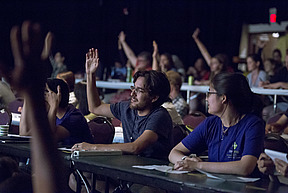
PCMI 2025 Undergraduate Faculty Program
The Undergraduate Faculty Program (UFP) at PCMI is aimed at faculty members from all types of colleges and universities with a strong interest in undergraduate teaching and research. Some participants are looking to rekindle their engagement with mathematical research and to interact with the broader mathematical community, while others are looking for new teaching approaches. The focus of the UFP varies from year to year, although its mathematical content is always aligned with the main research theme of PCMI that summer. In some years it is run as a small group seminar focused on some interesting parts of mathematics, in a setting which emphasizes participants working on ideas and problems together; in other years some part of it is also devoted to pedagogical issues or curriculum development. The UFP typically has around 10-12 participants, which allows for close and informal interactions among the participants.
UFP participants also interact with the participants and lecturers in the other programs, and in particular may choose to attend some of the Undergraduate and Graduate Summer School lecture series. Members from all parts of PCMI may take part in the Experimental Math Lab, in which small groups of participants with close mentorship from a more senior mathematician investigate open-ended problems and report on their findings at the end of the three-week Summer Session. Interaction among everyone at PCMI is fostered by various informal social activities open to all PCMI participants, as well as daily “cross-program activities’’ that include lectures and presentations on topics of general mathematical interest.
PCMI will be held July 6-26, 2025.
2025 Research Theme: Extremal and Probabilistic Combinatorics
The lecturer for the Undergraduate Faculty Program in 2025 will be Cory Palmer (University of Montana).
Combinatorics of Forbidden Substructures
Extremal combinatorics can be described as the study of the size and structure of discrete objects (e.g. sets, graphs, integers) subject to certain constraints, often a forbidden substructure requirement. A fundamental example is Mantel’s Theorem, which determines the maximum number of edges in a graph without a triangle subgraph. Another classic question: what is the maximum N such that the integers {1, 2, . . . , N } can be partitioned into two sets, neither of which contains a k-term arithmetic progression?
In this course, we will explore foundational results in extremal combinatorics and learn to apply some of the field’s most powerful tools, including the Szemerédi Regularity Lemma and Probabilistic Method. Along the way, we will discuss current research and investigate related open problems.

